一图胜千言!数据可视化多维讲解(1-6维)
「一图胜千言」
「一张图片的最大价值在于,它迫使我们注意到我们从未期望看到的东西。」 ——John Tukey
三、快速回顾可视化
import pandas as pd
import matplotlib.pyplot as plt
from mpl_toolkits.mplot3d import Axes3D
import matplotlib as mpl
import numpy as np
import seaborn as sns
%matplotlib inline
我们将主要使用 matplotlib 和 seaborn 作为我们的可视化框架,但你可以自由选择并尝试任何其它框架。首先进行基本的数据预处理步骤。
white_wine = pd.read_csv('winequality-white.csv', sep=';')
red_wine = pd.read_csv('winequality-red.csv', sep=';')
# store wine type as an attribute
red_wine['wine_type'] = 'red'
white_wine['wine_type'] = 'white'
# bucket wine quality scores into qualitative quality labels
red_wine['quality_label'] = red_wine['quality'].apply(lambda value: 'low'
if value <= 5 else 'medium'
if value <= 7 else 'high')
red_wine['quality_label'] = pd.Categorical(red_wine['quality_label'],
categories=['low', 'medium', 'high'])
white_wine['quality_label'] = white_wine['quality'].apply(lambda value: 'low'
if value <= 5 else 'medium'
if value <= 7 else 'high')
white_wine['quality_label'] = pd.Categorical(white_wine['quality_label'],
categories=['low', 'medium', 'high'])
# merge red and white wine datasets
wines = pd.concat([red_wine, white_wine])
# re-shuffle records just to randomize data points
wines = wines.sample(frac=1, random_state=42).reset_index(drop=True)
我们通过合并有关红、白葡萄酒样本的数据集来创建单个葡萄酒数据框架。我们还根据葡萄酒样品的质量属性创建一个新的分类变量 quality_label。现在我们来看看数据前几行。
wines.head()

subset_attributes = ['residual sugar', 'total sulfur dioxide', 'sulphates',
'alcohol', 'volatile acidity', 'quality']
rs = round(red_wine[subset_attributes].describe(),2)
ws = round(white_wine[subset_attributes].describe(),2)
pd.concat([rs, ws], axis=1, keys=['Red Wine Statistics', 'White Wine Statistics'])

wines.hist(bins=15, color='steelblue', edgecolor='black', linewidth=1.0,
xlabelsize=8, ylabelsize=8, grid=False)
plt.tight_layout(rect=(0, 0, 1.2, 1.2))
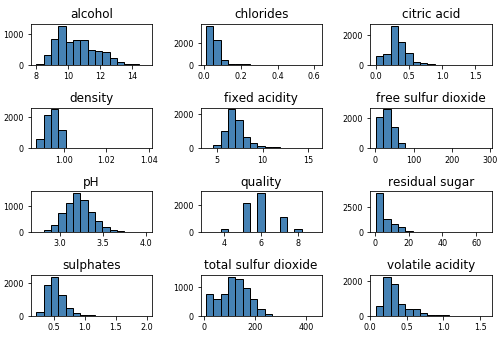
# Histogram
fig = plt.figure(figsize = (6,4))
title = fig.suptitle("Sulphates Content in Wine", fontsize=14)
fig.subplots_adjust(top=0.85, wspace=0.3)
ax = fig.add_subplot(1,1, 1)
ax.set_xlabel("Sulphates")
ax.set_ylabel("Frequency")
ax.text(1.2, 800, r'$\mu$='+str(round(wines['sulphates'].mean(),2)),
fontsize=12)
freq, bins, patches = ax.hist(wines['sulphates'], color='steelblue', bins=15,
edgecolor='black', linewidth=1)
# Density Plot
fig = plt.figure(figsize = (6, 4))
title = fig.suptitle("Sulphates Content in Wine", fontsize=14)
fig.subplots_adjust(top=0.85, wspace=0.3)
ax1 = fig.add_subplot(1,1, 1)
ax1.set_xlabel("Sulphates")
ax1.set_ylabel("Frequency")
sns.kdeplot(wines['sulphates'], ax=ax1, shade=True, color='steelblue')
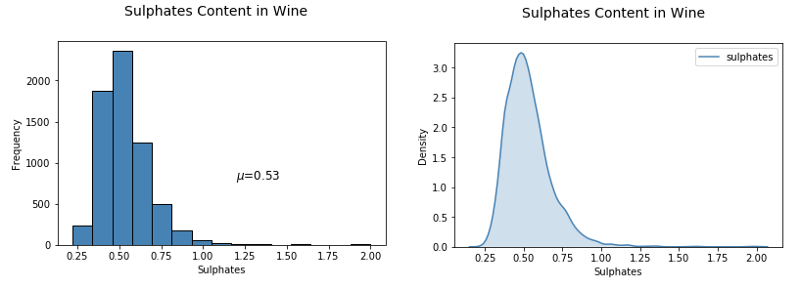
# Histogram
fig = plt.figure(figsize = (6,4))
title = fig.suptitle("Sulphates Content in Wine", fontsize=14)
fig.subplots_adjust(top=0.85, wspace=0.3)
ax = fig.add_subplot(1,1, 1)
ax.set_xlabel("Sulphates")
ax.set_ylabel("Frequency")
ax.text(1.2, 800, r'$\mu$='+str(round(wines['sulphates'].mean(),2)),
fontsize=12)
freq, bins, patches = ax.hist(wines['sulphates'], color='steelblue', bins=15,
edgecolor='black', linewidth=1)
# Density Plot
fig = plt.figure(figsize = (6, 4))
title = fig.suptitle("Sulphates Content in Wine", fontsize=14)
fig.subplots_adjust(top=0.85, wspace=0.3)
ax1 = fig.add_subplot(1,1, 1)
ax1.set_xlabel("Sulphates")
ax1.set_ylabel("Frequency")
sns.kdeplot(wines['sulphates'], ax=ax1, shade=True, color='steelblue')
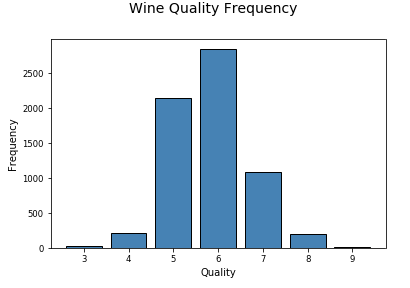
# Correlation Matrix Heatmap
f, ax = plt.subplots(figsize=(10, 6))
corr = wines.corr()
hm = sns.heatmap(round(corr,2), annot=True, ax=ax, cmap="coolwarm",fmt='.2f',
linewidths=.05)
f.subplots_adjust(top=0.93)
t= f.suptitle('Wine Attributes Correlation Heatmap', fontsize=14)
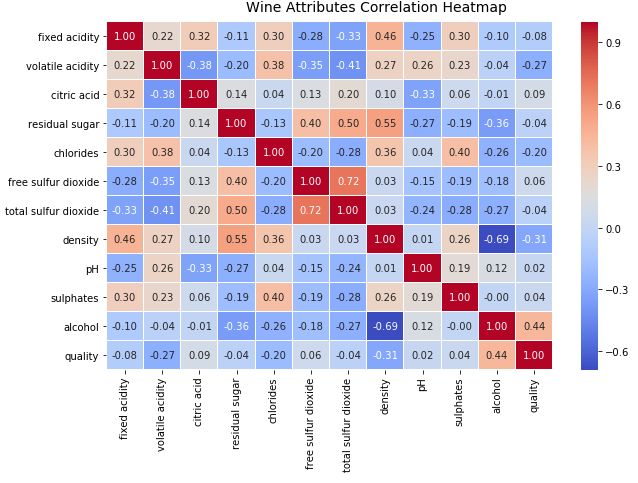
# Correlation Matrix Heatmap
f, ax = plt.subplots(figsize=(10, 6))
corr = wines.corr()
hm = sns.heatmap(round(corr,2), annot=True, ax=ax, cmap="coolwarm",fmt='.2f',
linewidths=.05)
f.subplots_adjust(top=0.93)
t= f.suptitle('Wine Attributes Correlation Heatmap', fontsize=14)

# Correlation Matrix Heatmap
f, ax = plt.subplots(figsize=(10, 6))
corr = wines.corr()
hm = sns.heatmap(round(corr,2), annot=True, ax=ax, cmap="coolwarm",fmt='.2f',
linewidths=.05)
f.subplots_adjust(top=0.93)
t= f.suptitle('Wine Attributes Correlation Heatmap', fontsize=14)
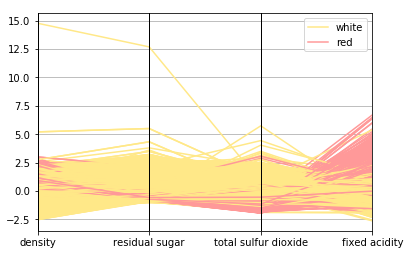
# Scatter Plot
plt.scatter(wines['sulphates'], wines['alcohol'],
alpha=0.4, edgecolors='w')
plt.xlabel('Sulphates')
plt.ylabel('Alcohol')
plt.title('Wine Sulphates - Alcohol Content',y=1.05)
# Joint Plot
jp = sns.jointplot(x='sulphates', y='alcohol', data=wines,
kind='reg', space=0, size=5, ratio=4)
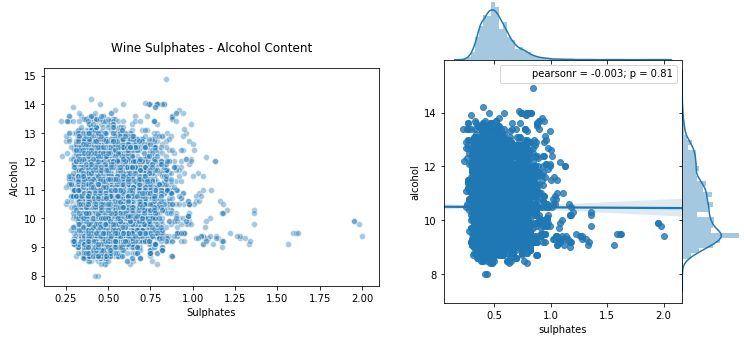
# Using subplots or facets along with Bar Plots
fig = plt.figure(figsize = (10, 4))
title = fig.suptitle("Wine Type - Quality", fontsize=14)
fig.subplots_adjust(top=0.85, wspace=0.3)
# red wine - wine quality
ax1 = fig.add_subplot(1,2, 1)
ax1.set_title("Red Wine")
ax1.set_xlabel("Quality")
ax1.set_ylabel("Frequency")
rw_q = red_wine['quality'].value_counts()
rw_q = (list(rw_q.index), list(rw_q.values))
ax1.set_ylim([0, 2500])
ax1.tick_params(axis='both', which='major', labelsize=8.5)
bar1 = ax1.bar(rw_q[0], rw_q[1], color='red',
edgecolor='black', linewidth=1)
# white wine - wine quality
ax2 = fig.add_subplot(1,2, 2)
ax2.set_title("White Wine")
ax2.set_xlabel("Quality")
ax2.set_ylabel("Frequency")
ww_q = white_wine['quality'].value_counts()
ww_q = (list(ww_q.index), list(ww_q.values))
ax2.set_ylim([0, 2500])
ax2.tick_params(axis='both', which='major', labelsize=8.5)
bar2 = ax2.bar(ww_q[0], ww_q[1], color='white',
edgecolor='black', linewidth=1)
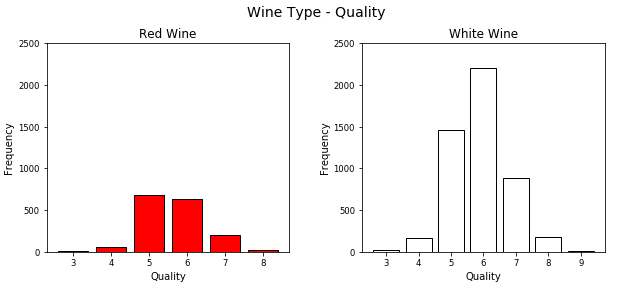
# Multi-bar Plot
cp = sns.countplot(x="quality", hue="wine_type", data=wines,
palette={"red": "#FF9999", "white": "#FFE888"})
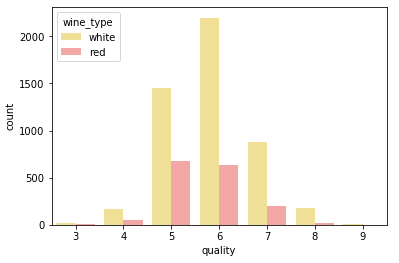
# facets with histograms
fig = plt.figure(figsize = (10,4))
title = fig.suptitle("Sulphates Content in Wine", fontsize=14)
fig.subplots_adjust(top=0.85, wspace=0.3)
ax1 = fig.add_subplot(1,2, 1)
ax1.set_title("Red Wine")
ax1.set_xlabel("Sulphates")
ax1.set_ylabel("Frequency")
ax1.set_ylim([0, 1200])
ax1.text(1.2, 800, r'$\mu$='+str(round(red_wine['sulphates'].mean(),2)),
fontsize=12)
r_freq, r_bins, r_patches = ax1.hist(red_wine['sulphates'], color='red', bins=15,
edgecolor='black', linewidth=1)
ax2 = fig.add_subplot(1,2, 2)
ax2.set_title("White Wine")
ax2.set_xlabel("Sulphates")
ax2.set_ylabel("Frequency")
ax2.set_ylim([0, 1200])
ax2.text(0.8, 800, r'$\mu$='+str(round(white_wine['sulphates'].mean(),2)),
fontsize=12)
w_freq, w_bins, w_patches = ax2.hist(white_wine['sulphates'], color='white', bins=15,
edgecolor='black', linewidth=1)
# facets with density plots
fig = plt.figure(figsize = (10, 4))
title = fig.suptitle("Sulphates Content in Wine", fontsize=14)
fig.subplots_adjust(top=0.85, wspace=0.3)
ax1 = fig.add_subplot(1,2, 1)
ax1.set_title("Red Wine")
ax1.set_xlabel("Sulphates")
ax1.set_ylabel("Density")
sns.kdeplot(red_wine['sulphates'], ax=ax1, shade=True, color='r')
ax2 = fig.add_subplot(1,2, 2)
ax2.set_title("White Wine")
ax2.set_xlabel("Sulphates")
ax2.set_ylabel("Density")
sns.kdeplot(white_wine['sulphates'], ax=ax2, shade=True, color='y')
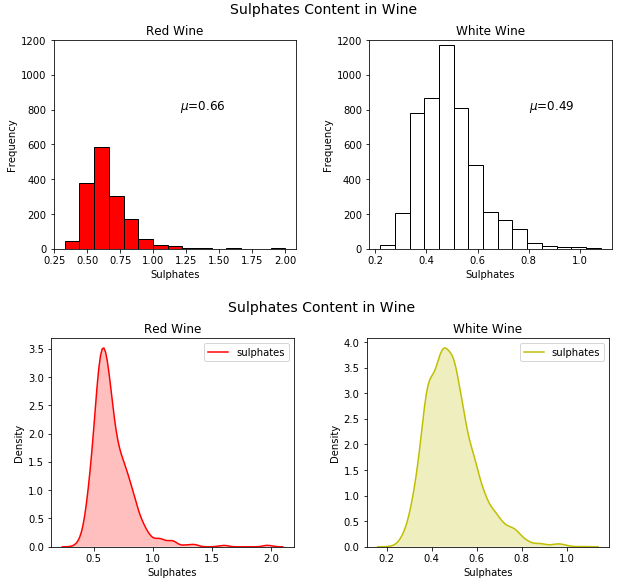
# Using multiple Histograms
fig = plt.figure(figsize = (6, 4))
title = fig.suptitle("Sulphates Content in Wine", fontsize=14)
fig.subplots_adjust(top=0.85, wspace=0.3)
ax = fig.add_subplot(1,1, 1)
ax.set_xlabel("Sulphates")
ax.set_ylabel("Frequency")
g = sns.FacetGrid(wines, hue='wine_type', palette={"red": "r", "white": "y"})
g.map(sns.distplot, 'sulphates', kde=False, bins=15, ax=ax)
ax.legend(title='Wine Type')
plt.close(2)
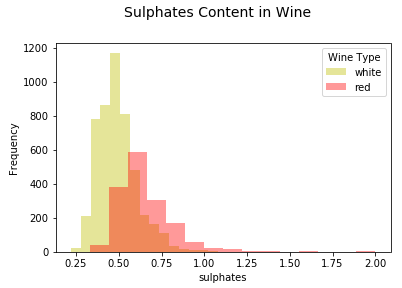
# Box Plots
f, (ax) = plt.subplots(1, 1, figsize=(12, 4))
f.suptitle('Wine Quality - Alcohol Content', fontsize=14)
sns.boxplot(x="quality", y="alcohol", data=wines, ax=ax)
ax.set_xlabel("Wine Quality",size = 12,alpha=0.8)
ax.set_ylabel("Wine Alcohol %",size = 12,alpha=0.8)
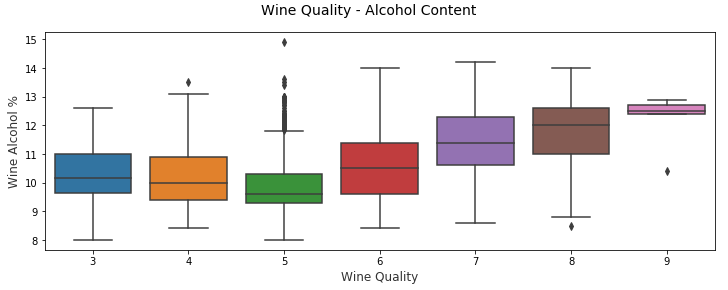
# Violin Plots
f, (ax) = plt.subplots(1, 1, figsize=(12, 4))
f.suptitle('Wine Quality - Sulphates Content', fontsize=14)
sns.violinplot(x="quality", y="sulphates", data=wines, ax=ax)
ax.set_xlabel("Wine Quality",size = 12,alpha=0.8)
ax.set_ylabel("Wine Sulphates",size = 12,alpha=0.8)
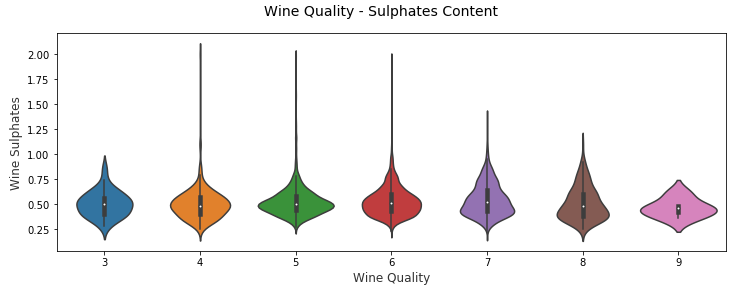
# Scatter Plot with Hue for visualizing data in 3-D
cols = ['density', 'residual sugar', 'total sulfur dioxide', 'fixed acidity', 'wine_type']
pp = sns.pairplot(wines[cols], hue='wine_type', size=1.8, aspect=1.8,
palette={"red": "#FF9999", "white": "#FFE888"},
plot_kws=dict(edgecolor="black", linewidth=0.5))
fig = pp.fig
fig.subplots_adjust(top=0.93, wspace=0.3)
t = fig.suptitle('Wine Attributes Pairwise Plots', fontsize=14)
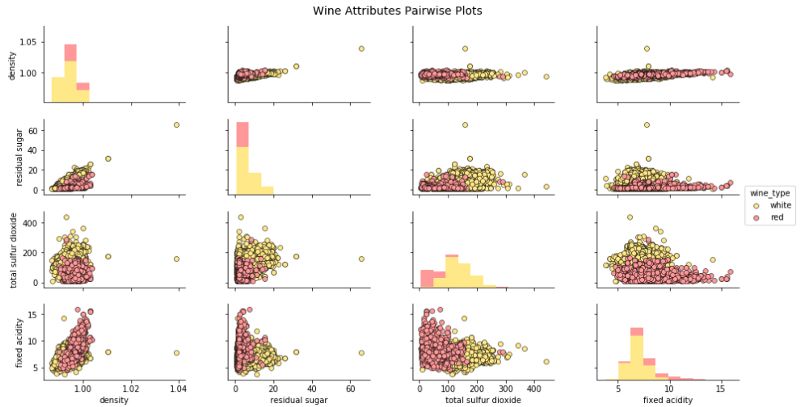
# Visualizing 3-D numeric data with Scatter Plots
# length, breadth and depth
fig = plt.figure(figsize=(8, 6))
ax = fig.add_subplot(111, projection='3d')
xs = wines['residual sugar']
ys = wines['fixed acidity']
zs = wines['alcohol']
ax.scatter(xs, ys, zs, s=50, alpha=0.6, edgecolors='w')
ax.set_xlabel('Residual Sugar')
ax.set_ylabel('Fixed Acidity')
ax.set_zlabel('Alcohol')

# Visualizing 3-D numeric data with a bubble chart
# length, breadth and size
plt.scatter(wines['fixed acidity'], wines['alcohol'], s=wines['residual sugar']*25,
alpha=0.4, edgecolors='w')
plt.xlabel('Fixed Acidity')
plt.ylabel('Alcohol')
plt.title('Wine Alcohol Content - Fixed Acidity - Residual Sugar',y=1.05)
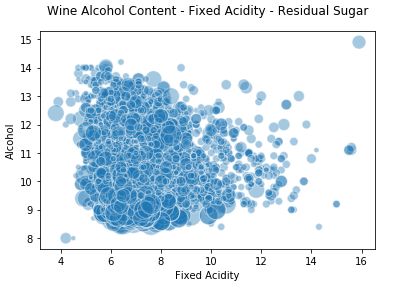
# Visualizing 3-D categorical data using bar plots
# leveraging the concepts of hue and facets
fc = sns.factorplot(x="quality", hue="wine_type", col="quality_label",
data=wines, kind="count",
palette={"red": "#FF9999", "white": "#FFE888"})

# Visualizing 3-D mix data using scatter plots
# leveraging the concepts of hue for categorical dimension
jp = sns.pairplot(wines, x_vars=["sulphates"], y_vars=["alcohol"], size=4.5,
hue="wine_type", palette={"red": "#FF9999", "white": "#FFE888"},
plot_kws=dict(edgecolor="k", linewidth=0.5))
# we can also view relationships\correlations as needed
lp = sns.lmplot(x='sulphates', y='alcohol', hue='wine_type',
palette={"red": "#FF9999", "white": "#FFE888"},
data=wines, fit_reg=True, legend=True,
scatter_kws=dict(edgecolor="k", linewidth=0.5))

# Visualizing 3-D mix data using kernel density plots
# leveraging the concepts of hue for categorical dimension
ax = sns.kdeplot(white_wine['sulphates'], white_wine['alcohol'],
cmap="YlOrBr", shade=True, shade_lowest=False)
ax = sns.kdeplot(red_wine['sulphates'], red_wine['alcohol'],
cmap="Reds", shade=True, shade_lowest=False)
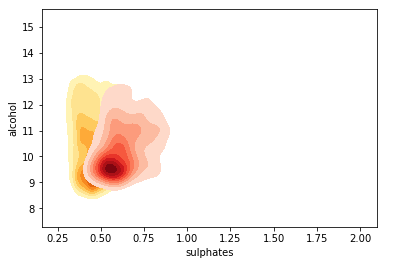
# Visualizing 3-D mix data using violin plots
# leveraging the concepts of hue and axes for > 1 categorical dimensions
f, (ax1, ax2) = plt.subplots(1, 2, figsize=(14, 4))
f.suptitle('Wine Type - Quality - Acidity', fontsize=14)
sns.violinplot(x="quality", y="volatile acidity",
data=wines, inner="quart", linewidth=1.3,ax=ax1)
ax1.set_xlabel("Wine Quality",size = 12,alpha=0.8)
ax1.set_ylabel("Wine Volatile Acidity",size = 12,alpha=0.8)
sns.violinplot(x="quality", y="volatile acidity", hue="wine_type",
data=wines, split=True, inner="quart", linewidth=1.3,
palette={"red": "#FF9999", "white": "white"}, ax=ax2)
ax2.set_xlabel("Wine Quality",size = 12,alpha=0.8)
ax2.set_ylabel("Wine Volatile Acidity",size = 12,alpha=0.8)
l = plt.legend(loc='upper right', title='Wine Type')
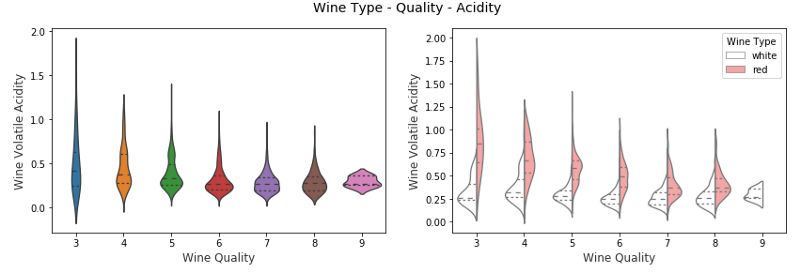
# Visualizing 3-D mix data using box plots
# leveraging the concepts of hue and axes for > 1 categorical dimensions
f, (ax1, ax2) = plt.subplots(1, 2, figsize=(14, 4))
f.suptitle('Wine Type - Quality - Alcohol Content', fontsize=14)
sns.boxplot(x="quality", y="alcohol", hue="wine_type",
data=wines, palette={"red": "#FF9999", "white": "white"}, ax=ax1)
ax1.set_xlabel("Wine Quality",size = 12,alpha=0.8)
ax1.set_ylabel("Wine Alcohol %",size = 12,alpha=0.8)
sns.boxplot(x="quality_label", y="alcohol", hue="wine_type",
data=wines, palette={"red": "#FF9999", "white": "white"}, ax=ax2)
ax2.set_xlabel("Wine Quality Class",size = 12,alpha=0.8)
ax2.set_ylabel("Wine Alcohol %",size = 12,alpha=0.8)
l = plt.legend(loc='best', title='Wine Type')
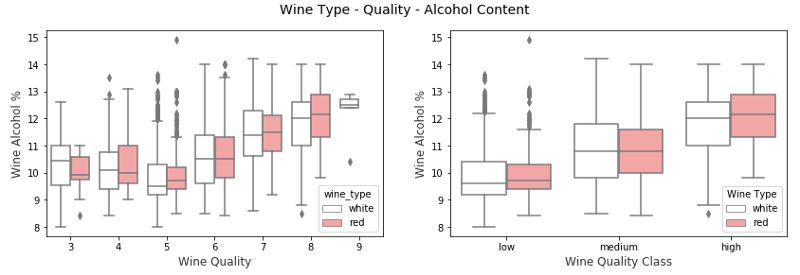
# Visualizing 4-D mix data using scatter plots
# leveraging the concepts of hue and depth
fig = plt.figure(figsize=(8, 6))
t = fig.suptitle('Wine Residual Sugar - Alcohol Content - Acidity - Type', fontsize=14)
ax = fig.add_subplot(111, projection='3d')
xs = list(wines['residual sugar'])
ys = list(wines['alcohol'])
zs = list(wines['fixed acidity'])
data_points = [(x, y, z) for x, y, z in zip(xs, ys, zs)]
colors = ['red' if wt == 'red' else 'yellow' for wt in list(wines['wine_type'])]
for data, color in zip(data_points, colors):
x, y, z = data
ax.scatter(x, y, z, alpha=0.4, c=color, edgecolors='none', s=30)
ax.set_xlabel('Residual Sugar')
ax.set_ylabel('Alcohol')
ax.set_zlabel('Fixed Acidity')
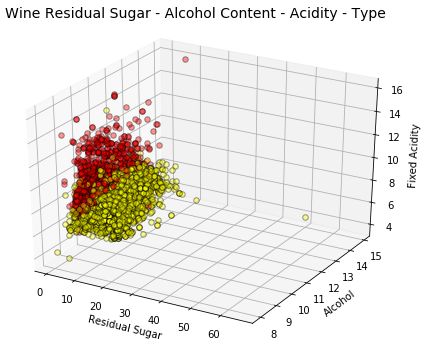
# Visualizing 4-D mix data using bubble plots
# leveraging the concepts of hue and size
size = wines['residual sugar']*25
fill_colors = ['#FF9999' if wt=='red' else '#FFE888' for wt in list(wines['wine_type'])]
edge_colors = ['red' if wt=='red' else 'orange' for wt in list(wines['wine_type'])]
plt.scatter(wines['fixed acidity'], wines['alcohol'], s=size,
alpha=0.4, color=fill_colors, edgecolors=edge_colors)
plt.xlabel('Fixed Acidity')
plt.ylabel('Alcohol')
plt.title('Wine Alcohol Content - Fixed Acidity - Residual Sugar - Type',y=1.05)
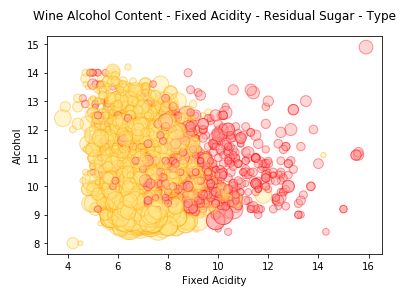
# Visualizing 4-D mix data using scatter plots
# leveraging the concepts of hue and facets for > 1 categorical attributes
g = sns.FacetGrid(wines, col="wine_type", hue='quality_label',
col_order=['red', 'white'], hue_order=['low', 'medium', 'high'],
aspect=1.2, size=3.5, palette=sns.light_palette('navy', 4)[1:])
g.map(plt.scatter, "volatile acidity", "alcohol", alpha=0.9,
edgecolor='white', linewidth=0.5, s=100)
fig = g.fig
fig.subplots_adjust(top=0.8, wspace=0.3)
fig.suptitle('Wine Type - Alcohol - Quality - Acidity', fontsize=14)
l = g.add_legend(title='Wine Quality Class')
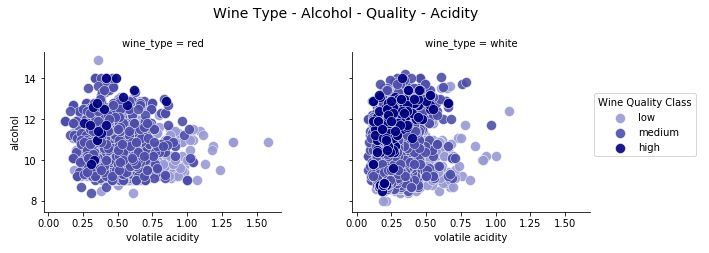
# Visualizing 4-D mix data using scatter plots
# leveraging the concepts of hue and facets for > 1 categorical attributes
g = sns.FacetGrid(wines, col="wine_type", hue='quality_label',
col_order=['red', 'white'], hue_order=['low', 'medium', 'high'],
aspect=1.2, size=3.5, palette=sns.light_palette('navy', 4)[1:])
g.map(plt.scatter, "volatile acidity", "alcohol", alpha=0.9,
edgecolor='white', linewidth=0.5, s=100)
fig = g.fig
fig.subplots_adjust(top=0.8, wspace=0.3)
fig.suptitle('Wine Type - Alcohol - Quality - Acidity', fontsize=14)
l = g.add_legend(title='Wine Quality Class')
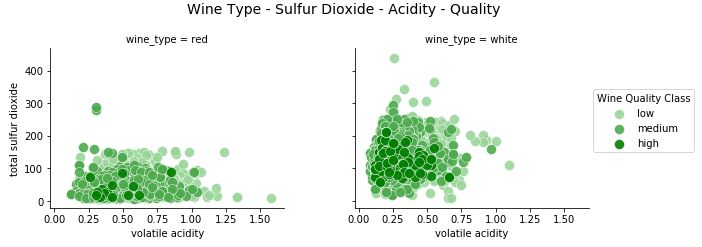
# Visualizing 5-D mix data using bubble charts
# leveraging the concepts of hue, size and depth
fig = plt.figure(figsize=(8, 6))
ax = fig.add_subplot(111, projection='3d')
t = fig.suptitle('Wine Residual Sugar - Alcohol Content - Acidity - Total Sulfur Dioxide - Type', fontsize=14)
xs = list(wines['residual sugar'])
ys = list(wines['alcohol'])
zs = list(wines['fixed acidity'])
data_points = [(x, y, z) for x, y, z in zip(xs, ys, zs)]
ss = list(wines['total sulfur dioxide'])
colors = ['red' if wt == 'red' else 'yellow' for wt in list(wines['wine_type'])]
for data, color, size in zip(data_points, colors, ss):
x, y, z = data
ax.scatter(x, y, z, alpha=0.4, c=color, edgecolors='none', s=size)
ax.set_xlabel('Residual Sugar')
ax.set_ylabel('Alcohol')
ax.set_zlabel('Fixed Acidity')
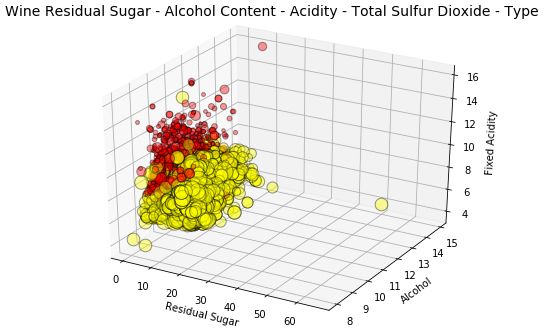
# Visualizing 5-D mix data using bubble charts
# leveraging the concepts of hue, size and depth
fig = plt.figure(figsize=(8, 6))
ax = fig.add_subplot(111, projection='3d')
t = fig.suptitle('Wine Residual Sugar - Alcohol Content - Acidity - Total Sulfur Dioxide - Type', fontsize=14)
xs = list(wines['residual sugar'])
ys = list(wines['alcohol'])
zs = list(wines['fixed acidity'])
data_points = [(x, y, z) for x, y, z in zip(xs, ys, zs)]
ss = list(wines['total sulfur dioxide'])
colors = ['red' if wt == 'red' else 'yellow' for wt in list(wines['wine_type'])]
for data, color, size in zip(data_points, colors, ss):
x, y, z = data
ax.scatter(x, y, z, alpha=0.4, c=color, edgecolors='none', s=size)
ax.set_xlabel('Residual Sugar')
ax.set_ylabel('Alcohol')
ax.set_zlabel('Fixed Acidity')
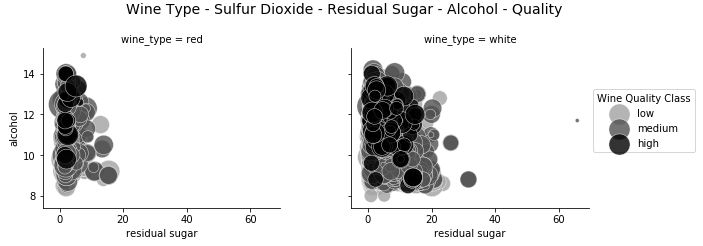

# Visualizing 6-D mix data using scatter charts
# leveraging the concepts of hue, size, depth and shape
fig = plt.figure(figsize=(8, 6))
t = fig.suptitle('Wine Residual Sugar - Alcohol Content - Acidity - Total Sulfur Dioxide - Type - Quality', fontsize=14)
ax = fig.add_subplot(111, projection='3d')
xs = list(wines['residual sugar'])
ys = list(wines['alcohol'])
zs = list(wines['fixed acidity'])
data_points = [(x, y, z) for x, y, z in zip(xs, ys, zs)]
ss = list(wines['total sulfur dioxide'])
colors = ['red' if wt == 'red' else 'yellow' for wt in list(wines['wine_type'])]
markers = [',' if q == 'high' else 'x' if q == 'medium' else 'o' for q in list(wines['quality_label'])]
for data, color, size, mark in zip(data_points, colors, ss, markers):
x, y, z = data
ax.scatter(x, y, z, alpha=0.4, c=color, edgecolors='none', s=size, marker=mark)
ax.set_xlabel('Residual Sugar')
ax.set_ylabel('Alcohol')
ax.set_zlabel('Fixed Acidity')
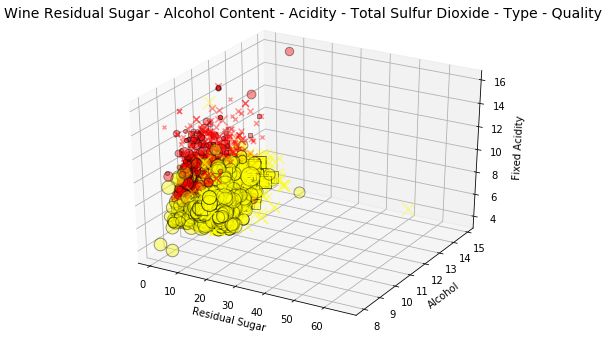
结合形状和 y 轴的表现,我们知道高中档的葡萄酒的酒精含量比低质葡萄酒更高。
结合色调和大小的表现,我们知道白葡萄酒的总二氧化硫含量比红葡萄酒更高。
结合深度和色调的表现,我们知道白葡萄酒的酸度比红葡萄酒更低。
结合色调和 x 轴的表现,我们知道红葡萄酒的残糖比白葡萄酒更低。
结合色调和形状的表现,似乎白葡萄酒的高品质产量高于红葡萄酒。(可能是由于白葡萄酒的样本量较大)
我们也可以用分面属性来代替深度构建 6 维数据可视化效果。
# Visualizing 6-D mix data using scatter charts
# leveraging the concepts of hue, facets and size
g = sns.FacetGrid(wines, row='wine_type', col="quality", hue='quality_label', size=4)
g.map(plt.scatter, "residual sugar", "alcohol", alpha=0.5,
edgecolor='k', linewidth=0.5, s=wines['total sulfur dioxide']*2)
fig = g.fig
fig.set_size_inches(18, 8)
fig.subplots_adjust(top=0.85, wspace=0.3)
fig.suptitle('Wine Type - Sulfur Dioxide - Residual Sugar - Alcohol - Quality Class - Quality Rating', fontsize=14)
l = g.add_legend(title='Wine Quality Class')
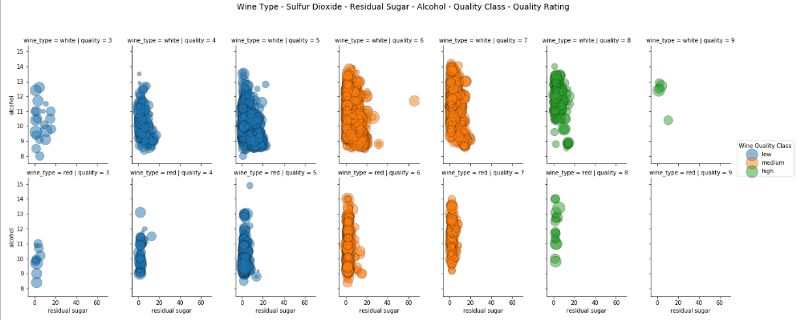
评论
